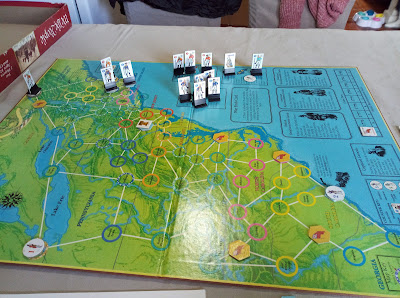
Armies are round counters, but are mostly ineffective unless they have a general with them, and both sides have a limited number of generals. Each is rated for two things - Strategy and Battle. Strategy dictates how easy it is to activate the general, whilst their Battle rating dictates how good they are in a fight. The British tend to have plodding generals who are good in a fight, and the Americans the reverse.
Here you can see Howe in Boston, with Washington and Green observing him. I played the Americans in this game, and Catherine the British.
The game itself is run by strategy cards. Each player gets a hand of seven of these, and they alternate in playing one until both players have none left. cards can be events, or (the majority) strategic operations cards, which allow the activation of generals, placement of political control markers or deployment of reinforcements.
If a general moves into a space with opposing troops, a battle is fought. These use another deck of cards, with various tactics on them (Flank Left, Frontal attack and so forth). each player gets a hand of cards, the number being based on their general's rating, how many units they have and various bonuses - The British get a bonus card for their regulars, and also two for naval support if the battle is fought in a port, for example. One side plays a card and the other side must match it or lose the battle. So a small army can, if they are lucky, defeat a larger force that got a bad draw. The losing side retreats and may lose units.
Here we see Washington attacking Howe at the end of the 1775 turn. Catherine evacuated Boston and sent Howe into the New York wilderness. Washington was able to use a special Winter Offensive bonus to drive him north at Saratoga. Over the next year or two he drove Howe all the way to Quebec, before being defeated, and ending up having to retreat back to where he started. He came close to being captured as his army suffered serious losses on the way.
Meanwhile Catherine had landed a couple of bodies of troops in the Carolinas. I'd been fortunate with the placement of political control markers and closed off most of the ports north of this area to her. Cornwallis and Burgoyne exerted some control over area, whilst Lee and Lincoln watched warily. But initially a lot of the activity was the placement and removal of markers rather than any actual fighting.
Eventually Lee attacked, driving Cornwallis out of Charleston, and then chasing him to New Bern. Lincoln came up in support, and eventually restricted the British to a couple of coastal enclaves.
In the north Washington had retreated to New York, but Howe followed and attacked, losing the ensuing battle despite having the odds seriously on his side. Had Washington lost he would have been left isolated without troops and vulnerable to capture. Washington was then able to escape along the coast back to Boston.
Lord North's government fell in 1781, which ended the war. The Americans controlled ten of the Thirteen Colonies, for a convincing with - the British controlled Canada, Massachusetts and New York, whilst Connecticut was still divided.







"they can score for Canada"
ReplyDeleteBut what about Florida? :D
According to this game Florida doesn't exist :)
Delete